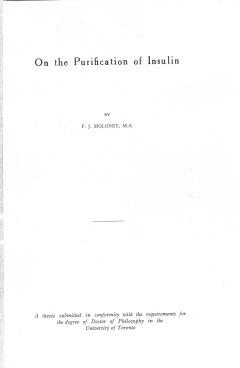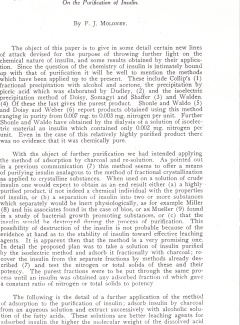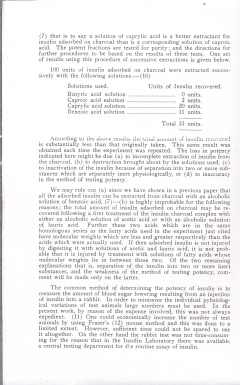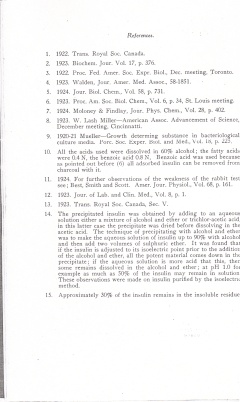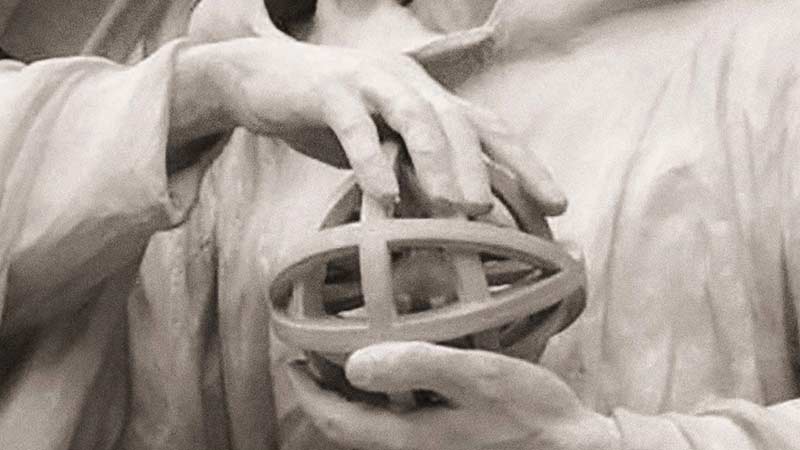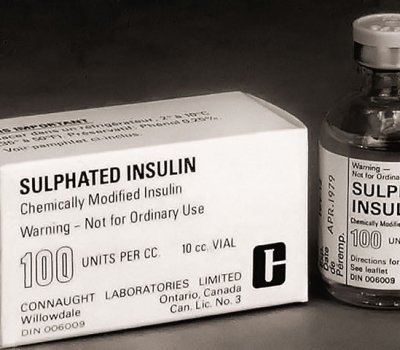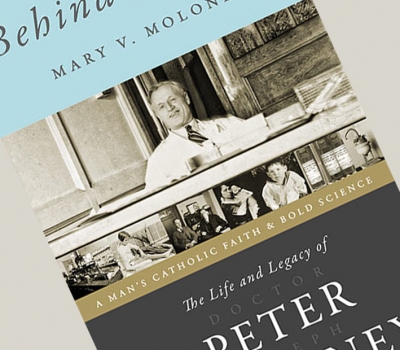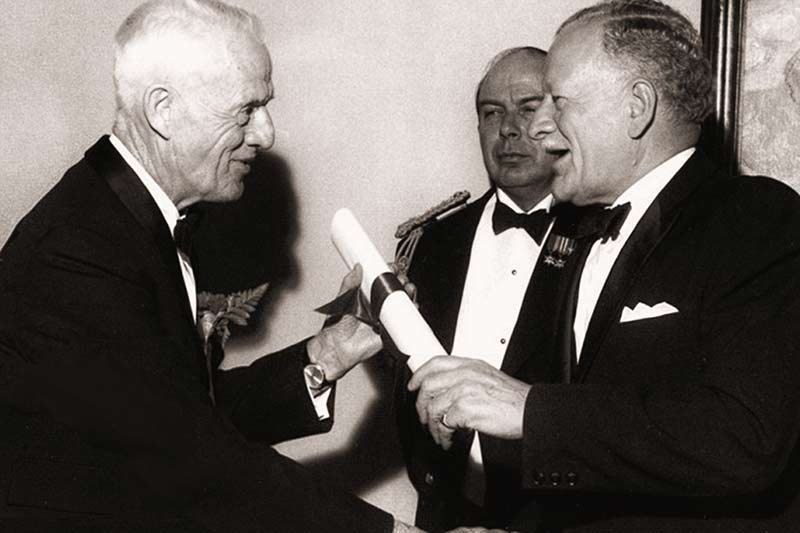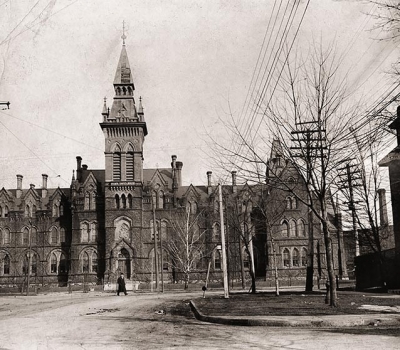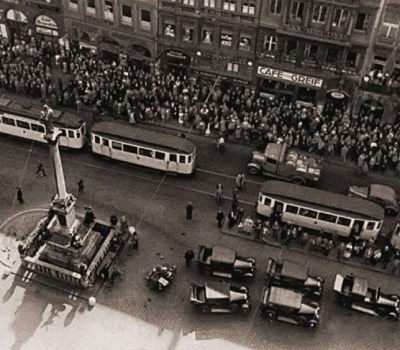Published here for the first time on the web is the historically significant Ph. D. thesis of Dr. Peter Joseph Moloney "On the Purification of Insulin".
Dr. Moloney was the first scientist in the world to work out the purification of insulin on the large scale in Toronto in May 1922, "some thousands of doses" (Oral History Interview, University of Toronto 1974).
On the Purification of Insulin
by P. J. Moloney
The object of this paper is to give in some detail certain new lines of attack devised for the purpose of throwing further light on the chemical nature of insulin, and some results obtained by their application. Since the question of the chemistry of insulin is intimately bound up with that of purification it will be well to mention the methods which have been applied up to the present. These include Collip's (1) fractional precipitation with alcohol and acetone, the precipitation by picric acid which was elaborated by Dudley, (2) and the isoelectric precipitation method of Doisy, Somagyi and Shaffer (3) and Walden (4). Of these the last gives the purest product. Shonle and Waldo (5) and Doisy and Weber (6) report products obtained using this method ranging in purity form 0.007mg. to 0.003 mg nitrogen per unit. Further Shonle and Waldo have obtained by the dialysis of a solution of isoelectric material an insulin which contained ony 0.002 mg nitrogen per unit. Even in the case of this relatively highly purified product there was no evidence that it was chemically pure.
With the object of further purification we had intended applying the method of adsorption by charcoal and re-solution. As pointed out in a previous communication (7) this method seems to offer a means of purifying insulin analagous to the method of fractional crystallization as applied to crystallin substances. When used on a solution of crude insulin one would expect to obtain as an end result either (a) a highly purified product, if not indeed a chemical individual with the properties of insulin, or (b) a separation of insulin into two or more substances which separately would be inert physiologically, as for example Miller (8) and his associates found in the case of bios, or as Mueller (9) found in a study of bacterial growth promoting substances, or (c) that the insulin would be destroyed during the process of purification. This possibility of destruction of the insulin is not probable because of the evidence at hand as to the stability of insulin toward effective leaching agents. It is apparent then that the method is a very promising one. In detail the proposed plan was to take a solution of insulin purified by the isoelectric method and adsorb it fractionally with charcoal; recover the insulin from the separate fractions by methods already described (7) and test the nitrogen or total solids of these and their potency. The purest fractions were to be put through the same process until an insulin was obtained any adsorbed fraction of which gave a constant ratio of nitrogen or total solids to potency.
The following is the detail of a further application of the method of adsorption to the purification of insulin: adsorb insulin by charcoal from an aqueous solution and extract successively with alcoholic solution of the fatty acids. these solutions are better leaching agents for adsorbed insulin the higher the molecular weight of the dissolved acid (7) that is to say a solution of caprylic acid is a better extractant for insulin adsorbed on charcoal than is a corresponding solution of caproic acid. The potent fractions are tested for purity; and the directions for further procedures to be based on the results of these tests. One set of results using this procedure of successive extractions is given below.
100 units of insulin adsorbed on charcoal were extracted successively with the following solutions: -(10)
Solutions used. Units of insulin recovered.
Butyric acid solution............................................0 units.
Caproic acid solution..........................................2 units.
Caprylic acid solution........................................20 units.
Benzoic acid solution.........................................11 units.
Total 33 units.
According to the above results the total amount of insulin recovered is substantially less than that originally taken. This same result was obtained each time the experiment was repeated. The loss in potency indicated here might be due (a) to incomplete extraction of insulin from the charcoal, (b) to destruction brought about by the solutions used, (c) to inactivation of the insulin because of separation into two or more substances which are separately inert physiologically, or (d) to inaccuracy in the method of testing potency.
We may rule out (a) since we have shown in a previous paper that all the adsorbed insulin can be extracted from charcoal with an alcoholic solution of benzoic acid, (7) (b) is highly improbable for the following reasons; the total amount of insulin adsorbed on charcoal may be recovered following a first treatment of the insulin charcoal complex with either an alcoholic solution of acetic acid or with an alcoholic solution of lauric acid. Further these two acids which are in the same homologous series as the fatty acids used in the experiment just cited have molecular weights which are less and greater respectively than the acids which were actually used. If then adsorbed insulin is not injured by digesting it with solutions of acetic and lauric acid, it is not probable that it is injured by treatment with solutions of fatty acids whose molecular weights lie in between these two. Of the two remaining explanations, that is, separation of the insulin into two or more inert substances, and the weakness of the method of testing potency, comment will be made only on the latter.
The common method of determining the potency of insulin is to measure the amount of blood sugar lowering resulting from an injection of insulin into a rabbit. In order to minimize the individual physiological variations of test animals large numbers must be used. In the present work, by reason of the expense involved, this was not always expedient. (11) One could economically increase the number of test animals by using Fraser's (12) mouse method and this was done to a limited extent. However, sufficient time could not be spared to use it altogether. On the other hand the rabbit test was not time-consuming for the reason that in the Insulin Laboratory there was available a central testing department for the routine assay of insulin.
Since a method of determining potency which would give reproducible results was not available it was decided to defer temporarily any attempts to purify insulin by adsorption.
The results given in the remaining part of this paper have to do with the solubility of insulin in the fatty acids. The potency tests on which they depend are only of a qualitative nature, nevertheless the results are of value. The general facts are these; insulin is soluble in glacial acetic acid (13) and it was found that some of the acids higher in the series precipitate the insulin from this solution depending on the acid used and the amount. The detailed results given in the table below were obtained by dissolving a dried precipitate (14) of insulin in glacial acetic acid (15) and adding to portions of this varying volumes of the acid under consideration. Where a precipitate formed this was separated by centrifuging and was tested for potency as were also the supernatants. (Refer to table in the document below)
In general the results given in this table show that the precipitating effect of the fatty acids for insulin dissolved in acetic acid increases with increasing molecular weights. It also indicates a new method for fractionating insulin by the use of a different set of solvents that those heretofore employed and hence one might expect a different type of purification. For reasons pointed out above tests for the purity of insulin obtained by this method of fractionation were not carried out except in one instance. This was with butyric acid. The acetic acid solution of insulin was first precipitated with two volumes of butyric, the precipitate which contained very little potency removed, and butyric acid added to the supernatant up to eight volumes. The resulting precipitate gave an insulin of the order of purity of 0.006 mg nitrogen per unit, which was in this case about twice as pure as the original material.
The paper details a plan for the purification by charcoal adsorption and gives some results obtained by the application of this method. Data regarding the precipitatng effects of various fatty acid on an acetic acid solution of insulin are set forth.
References
1. 1922. Trans. Royal Soc. Canada.
2. 1923. Biochem. Jour. Vol. 17, p. 376.
3. 1922. Proc. Fed. Amer. Soc. Expr. Biol., Dec. meeting, Toronto.
4. 1923. Walden, Jour. Amer. Med. Assoc., 58-1851.
5. 1924. Jour. Biol. Chem., Vol. 58, p. 731.
6. 1923. Proc. Am. Soc. Biol. Chem., Vol. 6, p. 34, St. Lous meeting.
7. 1924. Moloney & Findlay, Jour. Phys. Chem., Vol. 28, p. 402.
[This article was received for publication July 17, 1923, published Sept. 1923]
8. 1923. W. Lash Miller - American Asssoc. Advancement of Science, December meeting, Cincinnatti.
9. 1920-1921 Mueller - Growth determing substance in bacteriological culture media. Proc. Soc. Exper. Biol. and Med., Vol. 18, p. 225.
10. All the acids used were dissolved in 60% alcohol; the fatty acids were 0.4 N, the benzoic acid 0.8N, Benzoic acid was used because as pointed out before (6) all adsorbed insulin can be removed from charcoal with it.
11. 1924. For further observations of the weakness of the rabbit test see; Best, Smith and Scott. Amer. Jour. Physiol., Vol. 68, p. 161.
12. 1923. Jour. of Lab. and Clin. Med., Vol. 8, p. 1.
13. 1923. Trans. Royal. Soc. Canada, Sec. V.
14. The precipitated insulin was obtained by adding to an aqueous solution either a mixture of alcohol and ether or trichlor-acetic acid, in this latter case the precipitate was dried before dissolving in the acetic acid. The technique of precipitation with alcohol and ether was to make the aqueous solution of insulin up to 90% with alcohol and then add two volumes of sulphuric ether. It was found that if the insulin is adjusted to its isoelectric point prior to the addition of the alcohol and ether, all the potent material comes down in the precipitate; if the aqueous solution is more acid than this, then some remains dissolved in the alcohol and ether; at pH 1.0 for example as much as 50% of the insulin may remain in solution. These observations were made on insulin purified by the isoelectric method.
15. Approximately 30% of the insulin remains in the insoluble residue.
